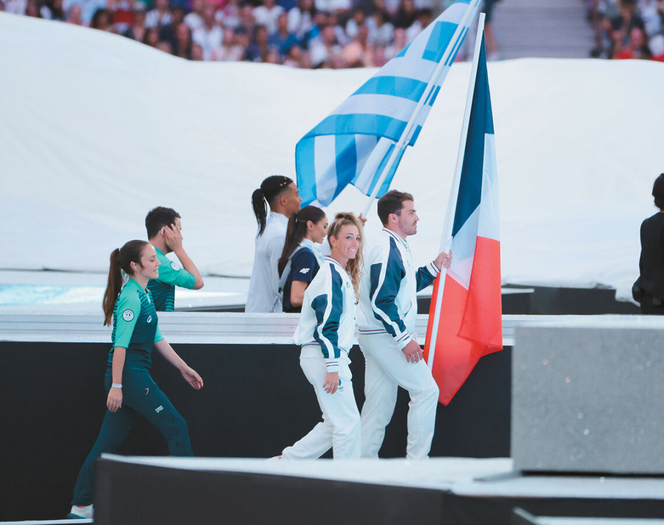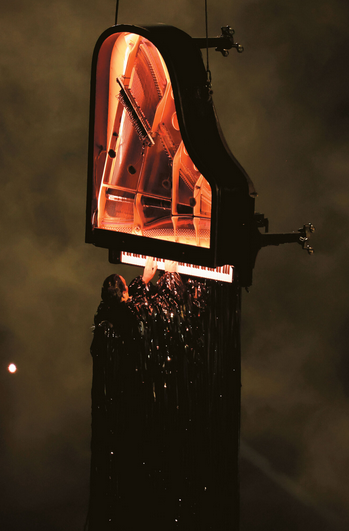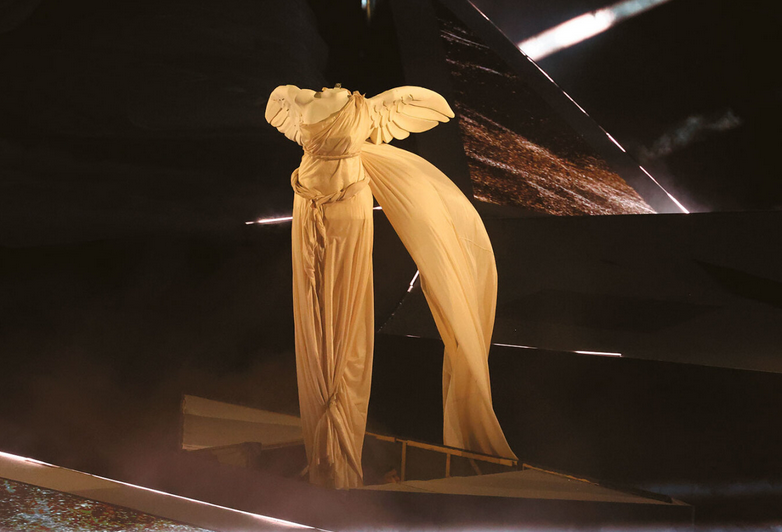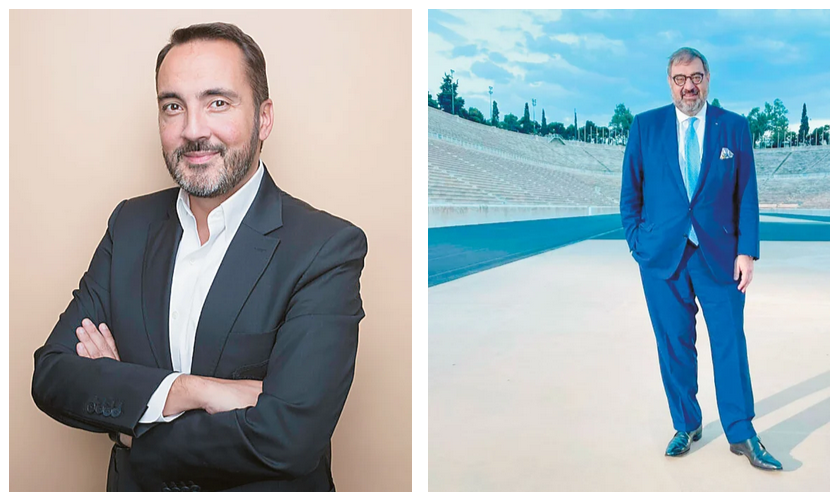It took countless events and many years for the Olympic officials to decide to honor the birthplace of the Games, Greece. If there is something memorable from the Paris Games, apart from the sports and unforgettable moments, it is their powerful closing ceremony, which, for the first time, celebrated and honored Greece and its spirit: the concept of creation and freedom through the Victory of Samothrace, the Olympic Idea through the renowned Hymn to Apollo, and the unification of all these in the Greek idea, highlighted by the raising of the Greek flag. From the moment the Olympic Flame left our country to reach the airship hovering over the Parisian sky, until the time Tom Cruise took the baton for the next Games in Los Angeles, Greece was a point of reference in every way.
Beyond the Greek symbols, Greeks were also the key figures who played a central role in the execution of the Olympic plan and its portrayal: Lambis Konstantinidis was the person in charge of the overall design of the Olympic Games, and Yiannis Exarchos was the one who transmitted the ceremonies and the entire event to us in a cinematic way, being the mastermind behind the broadcast coverage and the images that reached our screens.
From the moment the Olympic Flame departed from the Tuileries Garden, where it had hovered for days, and was carried by the French swimmer and Olympian Léon Marchand to the Stade de France, everyone knew that Greece had a special place—but they could not imagine exactly how.
Our suspicion, based on announcements circulated days before, that Greece would play a leading role in these Olympics began to be confirmed with the beautiful videos we saw from various parts of our country, through which the Flame passed, starting its journey from the vast, crystal-clear seas of the Aegean—the comparison with the murky waters of the Seine was unavoidable!—and from the stunning landscapes that cinematic footage, under the overall direction of Exarchos, showcased in the best possible way. However, nothing could compare to what followed: the beginning occurred when, in the darkened Stade de France, at the start of the grand performance titled “Record,” the Golden Researcher, with a somersault, found himself in a solitary world without the Olympic Games.

Both this golden being, which some said resembled a video game protagonist but was clearly conversing with the spirit of Freedom—the impressive golden statue that dominates the July Column in the heart of Place de la Concorde and symbolizes the struggles of the Bastille—as well as the steel equestrian figure, inspired by the reincarnated spirit of Joan of Arc, and the parkour athlete—these three central representatives of the Paris Games we saw at the opening ceremony—felt powerless to connect with a devastated humanity in a dystopian scenario where they were lost in a futureless landscape. They found a way to communicate through the Olympic Games, as Greece had invented and conveyed their spirit to the entire world. In the darkness, light began to shine slowly, and the Greek flag, respectfully carried, initially folded in the hands of the steel equestrian, became the ultimate symbol—and not only that, as the flag-raising ceremony was accompanied by the performance of our national anthem, specially arranged, which impressed the spectators of the stadium and the entire planet.
Apollo and Nike
Greece had once again performed a miracle through the Olympics, with the French eager to highlight the universal contribution of Greece: the alien dancers, having been mobilized by the Greek spirit, began to move upon hearing the Hymn to Apollo—the god who, according to Pausanias, played a central role in the Olympic Games by winning in the first symbolic contest among the gods, having defeated Hermes and Ares in running and boxing. In honor of Apollo, the Delphic Hymns were created, which were engraved in marble on the Treasure of the Athenians, possibly in 138 BC. These hymns-paeans present incidents from various stages of the god’s life and have musical symbols that have been decoded over time. It is no coincidence that the marble inscriptions of the Olympic Hymn are now housed in the Louvre Museum, bringing Apollo closer to the French.

As for the choice of the version of the Hymn played on the impressively floating piano by the flying pianist Alain Ross, it is anything but coincidental. This version was first heard in 1894 at the International Congress held in Paris for the revival of the Olympic Games, initiated by the Frenchman Pierre de Coubertin. This event ultimately led to the hosting of the first Modern Olympic Games in their birthplace, Greece, in 1896. From this congress emerged the International Olympic Committee (IOC), which was tasked with overseeing the Games, with the first president being Dimitrios Vikelas and the general secretary being Baron Pierre de Coubertin.
“Ancient Greece was a space of discovery for Pierre de Coubertin and his colleagues when he rediscovered and revived the Olympic Games. Thus, our history was born. Our character helped other explorers to awaken the remnants of the Games and rebuild them, because one day humanity created this monument, and it is worth continuing to keep it alive.”

At that moment, the title of the ceremony “Record,” reflecting the honor of athletic achievements, was introduced, as organizers noted while the stadium began to reveal depictions of athletes from ancient Greek black-figure vases on the stands, showcasing the historical continuity through the ages. As the climax of this elegiac tribute to Greekness and the Greek spirit of the Games, the statue of the goddess Nike emerged from the depths of the stadium. This statue, displayed at the Louvre Museum since 1884, is the most beautiful of the three Nikes found in the Sanctuary of Samothrace. The winged statue of the goddess, directly connected to the glorious concept of Victory and also chosen to adorn the medals awarded to athletes in Paris, appeared to almost hover in the center of the stadium, moving the crowds with its boundless beauty.
The Union of Nations
Thus, there could be no better way to highlight the Greek spirit and the unadorned beauty of the Games through its ancient Greek symbols, which continue to glorify and demonstrate the central spirit and fundamental principle of reconciliation that the Games teach—even though this year the central principle of the truce was not observed. By celebrating the mastery of the Greeks, the French showed in their imaginative way that the Olympic Games are one of humanity’s fundamental inventions: the invention of the wheel, presented at the closing ceremony, was symbolically linked to the emblem of the Olympic Games by connecting it with the existence of the Renaissance Vitruvian Man.

All the nations were now gathered in the stadium for this union of spirits and souls, and under the sentiment of “mutual respect, which is the first foundation of maintaining peace among nations,” as the organizers stated, the party and the spectacular show could begin. The grand finale was marked by the reception of the Flame, with a spectacular leap to the center of the Stade de France by the most representative American figure for dangerous missions, Tom Cruise.
The Plan
However, many say that what distinguished these Olympics, apart from the central ideas of inclusion, individuality, and respect, was that they were kept within reasonable bounds, without the excesses of previous Games. The approach highlighted by the now-specialist in the Games, Lampis Konstantinidis, who had gained his experience from the Athens Olympics and was responsible for the overall design of the Paris Games, was to maintain balance, avoiding the expenditure of massive amounts on facilities that would later remain underutilized, as happened with the Olympic projects in Athens.
Even though athletes sometimes reacted to the ecological spirit of the French, which deprived them of cooling comforts in the Olympic Village and forced them to sleep on cardboard beds, the French, through Konstantinidis, insisted that the goals of ecology, responsibility, universality, and inclusion had been achieved. After all, as the Greek organizer had argued long before the Games, many things have changed since Pierre de Coubertin and Dimitrios Vikelas envisioned the Games, and what keeps them alive is precisely this adaptability program. Certainly, there was no better advisor in this regard than Konstantinidis, who had worked on a series of events since the Athens Olympics: Torino 2006, Beijing, Vancouver, London, Sochi, and he also has experience with Pan American Games.

He speaks five languages, which helps him to cope and understand different cultures, finding solutions where others encounter only dead ends. A similar achievement was seen at the Paris Olympics, where the nearly impossible equation of openness and security was successfully resolved, with the Games being open to all while maintaining strict security due to the critical state of the global community. It was a high-risk plan that the Greek Design Lead put on the table, and with the support of his entire team, he can now speak of highly successful Games that were also a huge celebration with packed stadiums and record ticket sales.
And while all of this pertained to those who were in Paris and experienced the atmosphere firsthand, all of us who enjoyed the Games from home and felt virtually present owe it to the Greek CEO responsible for the International Olympic Committee’s media coverage, who, along with his countless collaborators, ensured that the ideal image of the Olympics reached us and that their magic was conveyed to the fullest. That’s why this year, Giannis Exarchos promised to make a difference with the cinematic coverage of the Games, aided by technology.
See you in L.A.
For the first time, we saw the birthplace of the Lumière brothers honor its name, and a Greek once again put his stamp on a unique representation that aimed—and succeeded—in making these Games unforgettable and making us happy that our country was represented at different levels in the best possible way. It was time to remember the motto that has now gone down in history, “Greece – France – Alliance,” putting aside any possible reactions during the opening ceremony and remembering that the Olympic Games symbolize a spirit of reconciliation, unity, and peace—the very reason they were established and why they continue to be honored every four years—with the next appointment set for Los Angeles in 2028.
Ask me anything
Explore related questions





